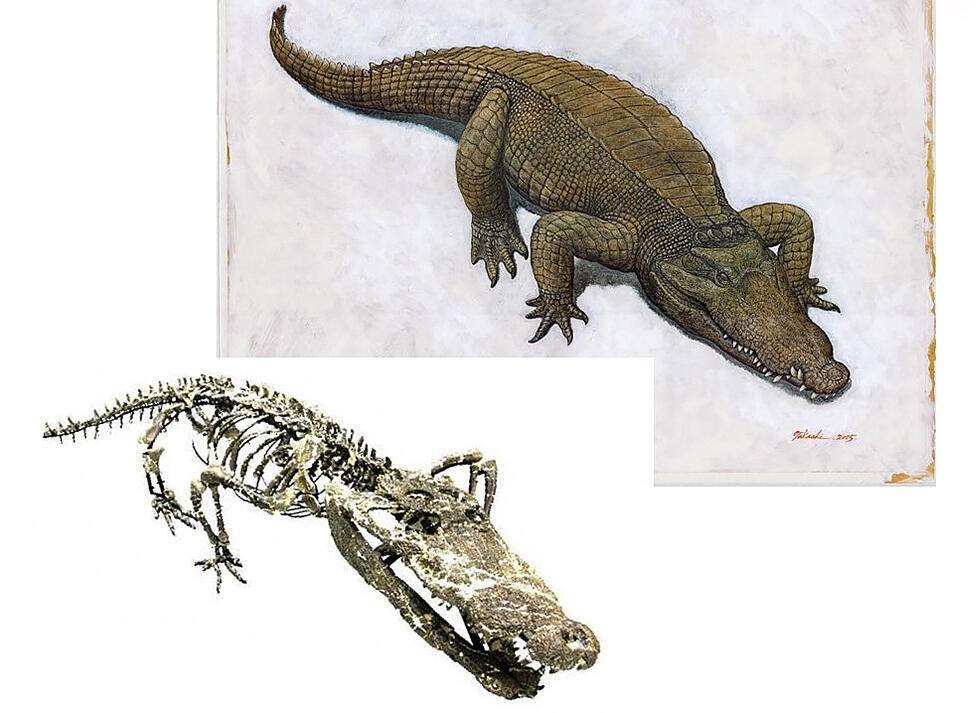The research group composed of Curator Junki Yoshida of Fukushima Prefectural Museum, Professor Yoshitsugu Kobayashi of Hokkaido University Museum, Chief Yuji Takakuwa of Gunma Museum of Natural History Geology Research Section, and others revealed that a new species of Goniopholis, a close relative of the crocodile, was found in the Late Jurassic strata dating to about 155 million years ago, and announced that it was named "Amphicotylus milesi. Focusing on the "hyoid bone" and "inner nose" of the anabolic fossils, the group investigated and compared these organs and functions of previously discovered fossils of crocodile relatives and vertebrates, including the modern crocodile. It was revealed that the origin of the mechanism for aquatic adaptation of modern crocodiles dates back to the Jurassic period. This research is expected to lead to the elucidation of the evolution of living things. The results were published in Royal Society Open Science published by the Royal Society in the U.K.

The ancestors of crocodiles are thought to have advanced from the land where they lived to the water during the Mesozoic era (Triassic, Jurassic, Cretaceous), when dinosaurs prospered on land. Goniopholis are closely related to modern crocodiles and are expected to provide clues to the dynamic evolutionary process of crocodile ancestors' advance into the water, with their primitive but similar characteristics to modern crocodiles. The fossils studied this time were discovered by Clifford Miles and others in Wyoming, USA, in 1993, along with multiple animal fossils such as Camarasaurus (dinosaurs) from the Late Jurassic (about 155 million years ago) strata. The excavation was jointly conducted with the Gunma Museum of Natural History.
Later, when the excavated Camarasaurus was stored in the museum in 1996, it was donated as Goniopholis (presumed) fossils excavated from the same stratum. Almost the entire body of the fossil remained, and despite the tip of the tail being missing, it was extremely well preserved. However, no academic research had been conducted so far. Research started when Curator Yoshida was enrolled in graduate school at Hokkaido University.
In addition to investigating the fossils in detail, phylogenetic analysis was performed by investigating and comparing fossils of other Goniopholis, mainly in North America, and the research group identified the fossils as Goniopholis based on factors such as the presence of a wide mouth and the posterior fossa of the inner nostril. It was named "Amphicotylus milesi" after one of the discoverers, Mr. Miles. Further research focused on the "inner nostril" and "hyoid bone", which had not received much attention until then.
The aquatic-adapted modern crocodile has an organ called the "hyoid flap", which is peculiar to the crocodile, at the base of the tongue, which lifts up to prevent water from entering the throat. On the other hand, the origin of these mechanisms was unknown because the tissues that support the "hyoid flap" and "hyoid bone" do not remain in fossils. It was also considered that the "inner nostril" at the posterior end of the nasal passage must be located behind the "hyoid flap" for the flap to function. These allow the crocodile to breathe by lifting only its nose out of the water.
The group examined the "ceratobranchial bone", which is a part of the "hyoid bone", in specimens of crocodylomorpha and vertebrates from all over the world. Then, it was found that Neosuchia, including modern crocodiles and Goniopholis, have a relatively small "ceratobranchial bone" with respect to the head and it is curved like a boomerang. In contrast, many other vertebrates on land and fossils closely related to crocodiles that lived on land have no curvature. Furthermore, the position of the "inner nostril" is measured in the same way.
In Neosuchia, it was possible to quantitatively confirm that the position of the "inner nostril" has moved backward. Further, to investigate why the Neosuchia "ceratobranchial bone" is curved, two types of modern crocodile (Crocodylus siamensis and Alligator sinensis) were dissected and the structure of the "hyoid flap" was investigated. As a result, it was clarified that in modern crocodiles, the ceratobranchial bone muscle attaches with a tendon between the posterior part of the ceratobranchial bone and the anterior part of the hyoid bone, and has the function of lifting the hyoid flap. It was clarified that the "hyoid flap" functions as a result of the increase of the moment arm of the same muscle due to the curvature of the ceratobranchial bone. It is believed that "Amphicotylus milesi" also possessed a "hyoid flap" like the modern crocodile.

From this, it became clear that the aquatic adaptation system using the "hyoid flap" in the modern crocodile was already established before the Late Jurassic period, in the common ancestor of Goniopholis and the crocodile. There is a stratum of the same era in Japan, and it is possible that the mystery of evolution will be further elucidated by finding new fossils. The Gunma Museum of Natural History (Tomioka City, Gunma Prefecture) is currently exhibiting the skull of "Amphicotylus milesi,". The exhibition will be held at Fukushima Prefectural Museum (Aizuwakamatsu City, Fukushima Prefecture) from next year onwards.
Curator Yoshida spoke on the finding, saying "This time, we have clarified a part of aquatic adaptation, but there are still many mysterious points to be solved in the evolution of the crocodile. We are expecting further developments in the future."
This article has been translated by JST with permission from The Science News Ltd.(https://sci-news.co.jp/). Unauthorized reproduction of the article and photographs is prohibited.




